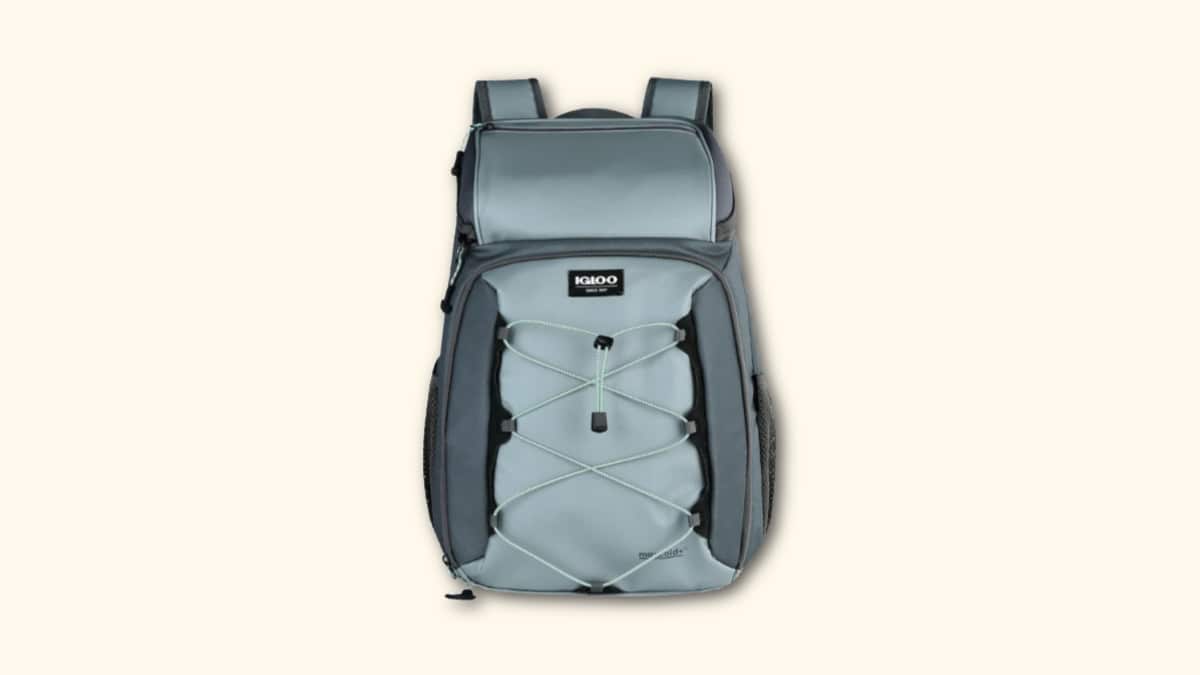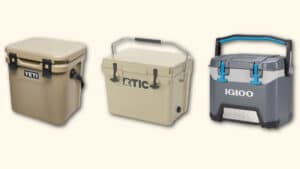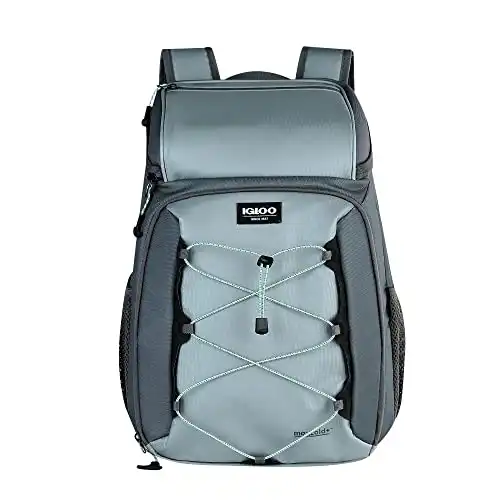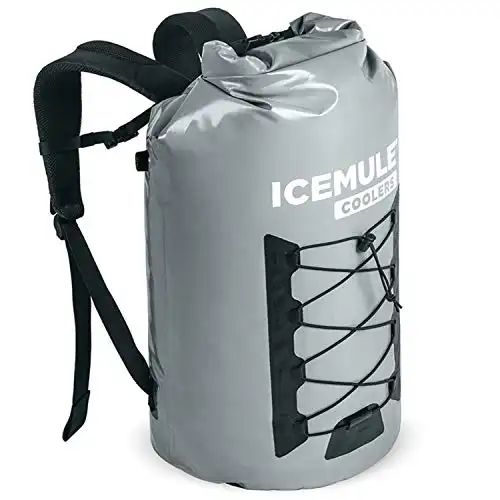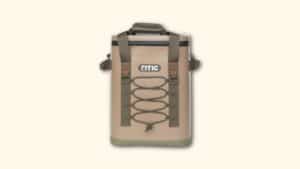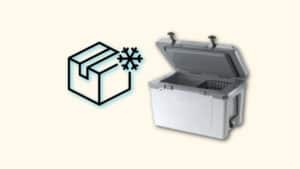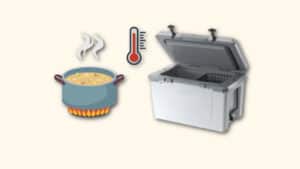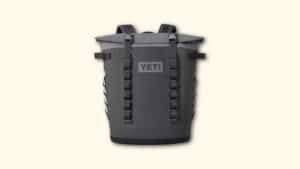Pros:
- Multiple compartments make it easy to load up a picnic and your essentials like a wallet, phone, and keys
- Of the sub-$100 coolers I tested, Igloo had the best insulation
- There are a lot of cool features built into this bag, from elastic mesh side panels, a bottle opener, t-handles on the zippers, and an elastic bungee cord on the front
Cons:
- The multiple pocket system is great for a picnic for two and separating drinks from foods, etc. But it reduces the capacity if you’re just looking to bring drinks
- It doesn’t look cool in my opinion
What’s better than throwing some drinks and snacks on your back and heading out into nature?
Sometimes that’s all you need to clear your mind.
And I’m the kind of person who also gets peace of mind knowing I’m carrying the best gear.
So I went out and picked up five of the most popular backpack coolers and tested them all against one another.
In this review, I’m not only looking at the Igloo MaxCold Voyager backpack cooler, but also the YETI Hopper M20, the RTIC 20-Can, the Icemule Pro, and the Tourit Cockatoo.
There are pros, cons, and best-use cases for each. Keep reading to see my results.
SKIP AHEAD
Igloo MaxCold Voyager Backpack Cooler Overview
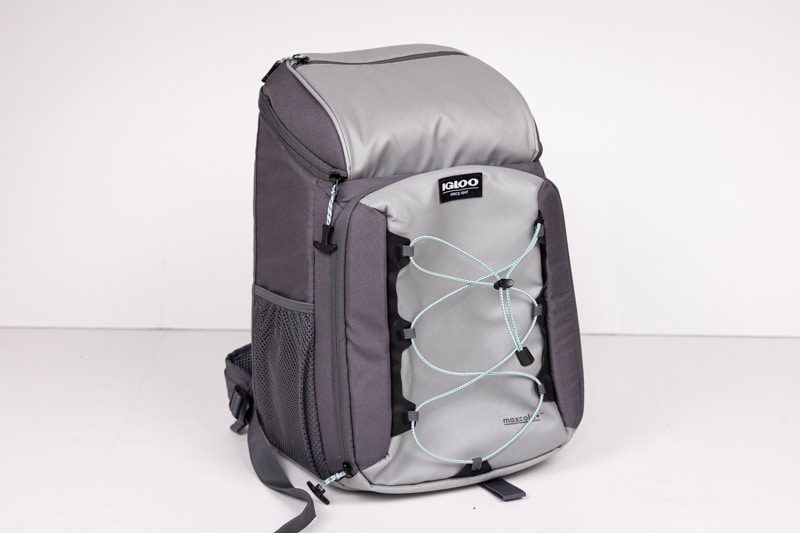
The Igloo MaxCold Voyager backpack cooler is similar to the Igloo Gizmo—the brand’s most popular backpack cooler. But the MaxCold Voyager is a step up in insulation and features.
Because it’s not much more expensive than the Gizmo, I figured I’d give it a try.
It can hold 30 cans, though that’s only with an ice-pack, and when I tried that, none of the drinks really got all that cold. So I would actually consider this to be more of a 20-can max if you plan on adding ice to actually get your contents cold.
Igloo has a few more premium backpack coolers available, but I wanted to add a few sub-$100 coolers to my tests to see if there was a great budget option.
The Igloo MaxCold Voyager offers solid value for money, and if you need a cooler backpack for an upcoming trip, it's not a bad choice. I don't see this lasting more than 5 years though, and I personally would rather get something that I know will last a decade or longer.
Things to Consider Before Buying an Igloo Backpack Cooler
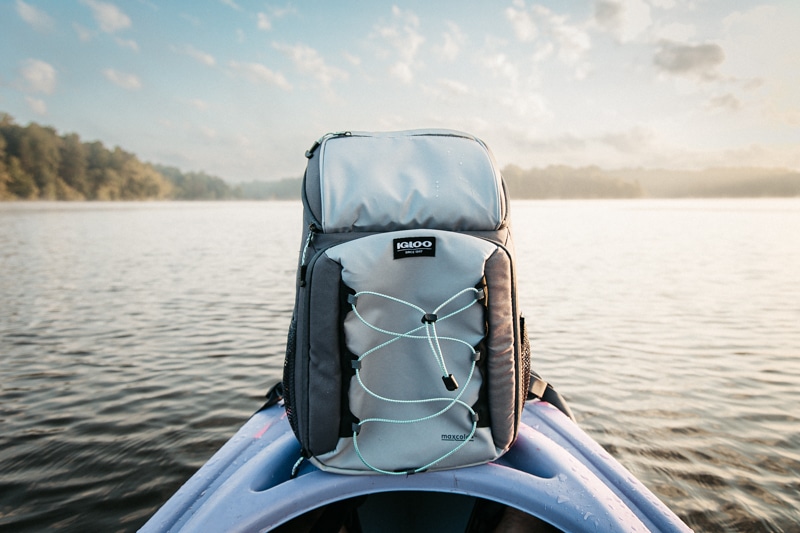
Of the backpack coolers I tested that cost less than $100, the Igloo MaxCold Voyager was the best. So if you’re not looking to spend over $100, well, you know my recommendation.
But I think the best value for money pick you can make is the Icemule Pro XL 33L. It’s water-tight, has excellent insulation, looks awesome, and has a rugged rubberized ripstop exterior.
The Icemule Pro XL is my top pick for backpack coolers. I love the way it looks, the insulation is fantastic, and the price is right. It can hold its own against YETI despite being less than half the price.
The Icemule costs almost double what the Igloo Voyager does, but if you plan on using your backpack cooler on any nature excursions, or want something that’ll last more than 5 years, then the Icemule is a better investment.
Another important consideration is that the Igloo MaxCold Voyager had the most pockets of any backpack cooler I tested, which is fantastic if you have kids and need lots of sub-compartments to store their various knick-knacks.
Why You Should Trust Me
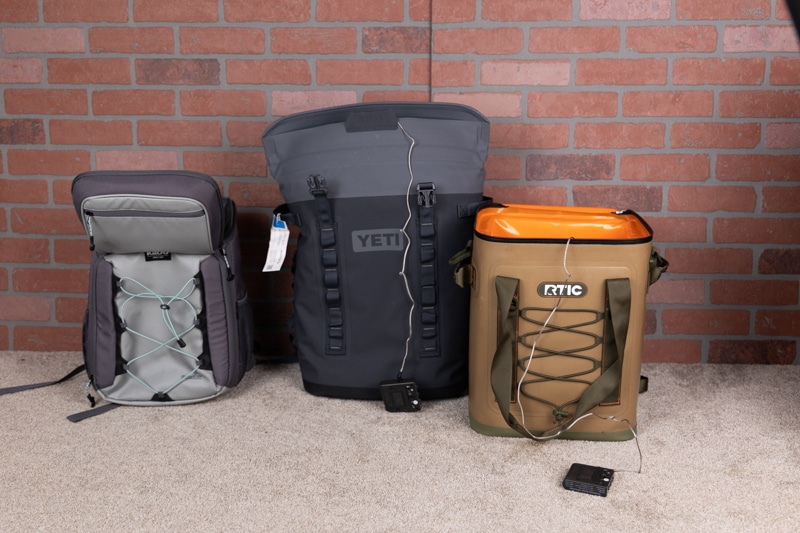
Before writing this review, I tested five of the most popular backpack coolers on the market: the Igloo MaxCold Voyager, the YETI Hopper M20, the RTIC 20-Can, the Icemule Pro XL 33L, and the Tourit Cockatoo.
For each cooler, I put 3.5 lbs of ice, sealed them, and measured the internal temperature for 40 hours.
I also had the chance to do some sort of excursion with each cooler to see what it was actually like to bring the cooler around for a day and get to know its comparative strengths and weaknesses.
So I not only know how the Igloo MaxCold Voyager performs, but I also know how it performs in comparison to other brands.
Igloo Backpack Cooler Review
Value

The Igloo MaxCold Voyager is well below $100, which is one of the main reasons I wanted to give it a try: to see if it’s a good budget-friendly option.
The only other cooler I tested near this price range was the Tourit Cockatoo, and while the Tourit is about 25% less expensive than the Igloo, you’re getting a far better value with the Igloo.
The Tourit Cockatoo isn't great with insulation. It's better to think of it as a backpack with insulation rather than a cooler. If you need a lot of compartments and only need to keep a chill for six hours or so, the Tourit Cockatoo is great. But for all-day frostiness, you'll want something more robust.
I think the real question is whether you should get the extreme budget-friendly Igloo backpack cooler, or step up the investment to an Icemule Pro, which is my top value-for-money pick.
Of course, there’s the YETI Hopper M20, but at over $300, it’s not really in the “budget-friendly” category at all. It is a great cooler, though.
The Hopper M20 Backpack Soft Cooler allows you to put the day on your back — literally. This hands-free soft cooler keeps you mobile, while an ultra-strong magnet strip keeps the cold locked in and the hot air out.
I think the Igloo MaxCold Voyager is a solid value, but I’m a very active person who likes to go kayaking, hiking, and fishing, and I’m not particularly easy on my gear when I do any of that.
So when I came down to adventure-time, I felt the soft fabric shell of the Igloo and the construction just wasn’t what I needed. I’m the kind of person who is willing to pay a little extra for something I know will last a long time.
While I feel that the Igloo is a good backpack cooler, I’m not 100% confident it’s going to endure through the impact-heavy things I get into regularly.
Capacity
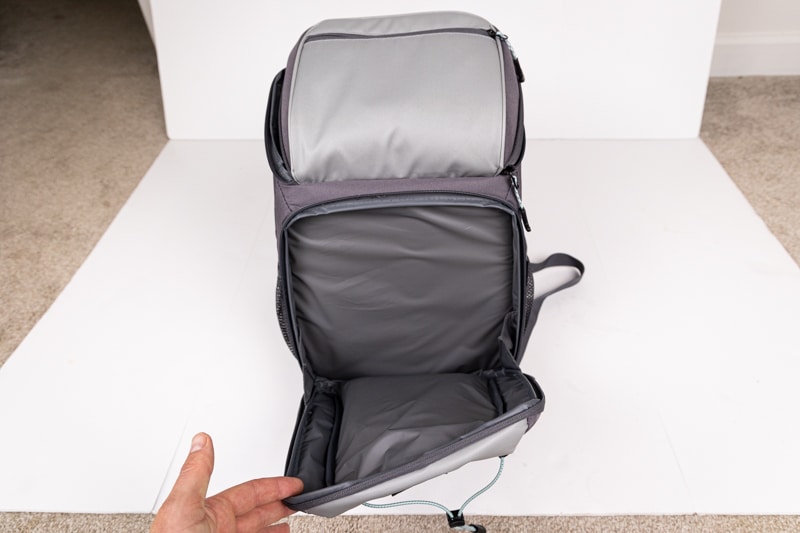
When looking at the capacity, I like to not only measure how much a cooler can hold, but also how “efficient” the cooler is with that space. Some designs can hold several more cans than others, despite the coolers being the same size externally.
So I measure what I call the “space efficiency ratio,” which is just the liter capacity divided by the number of cans the cooler can hold with ice.
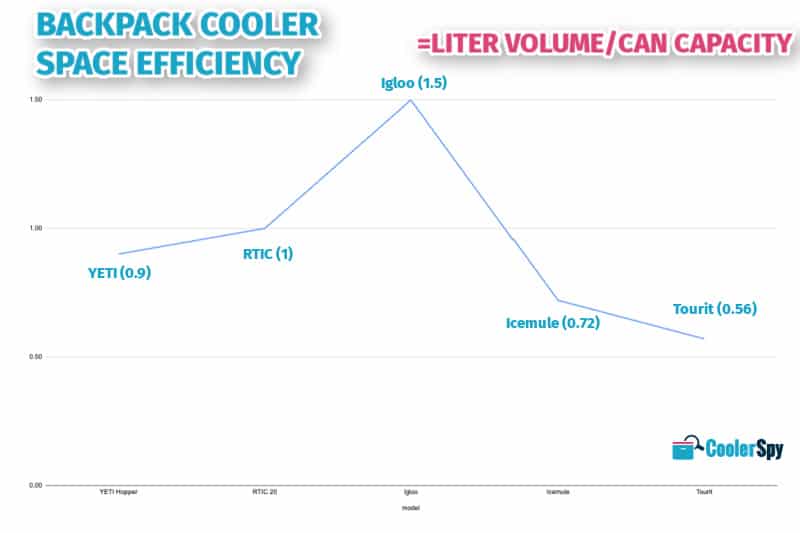
The Igloo MaxCold Voyager’s space efficiency ratio rating is 1.5, which is the highest of the five backpack coolers I tested.
That basically means that compared with the external size of the cooler, the Igloo can hold the most cans. A big part of this is that the Igloo has a front pouch with a lot of room in it. You wouldn’t necessarily always use that for storing more cans—you’d probably put your food or some dry goods in that compartment
The Igloo MaxCold Voyager offers solid value for money, and if you need a cooler backpack for an upcoming trip, it's not a bad choice. I don't see this lasting more than 5 years though, and I personally would rather get something that I know will last a decade or longer.
Icemule’s space efficiency ratio rating is 0.72, which is below the average of the five coolers I tested. This is because there’s a lot of extra fabric at the top that you need to make the roll top closure work.
The Igloo MaxCold Voyager’s size is ideal for a full picnic for two, and you could probably pack a light picnic for four in there.
Here are the actual capacities for all the coolers tested:
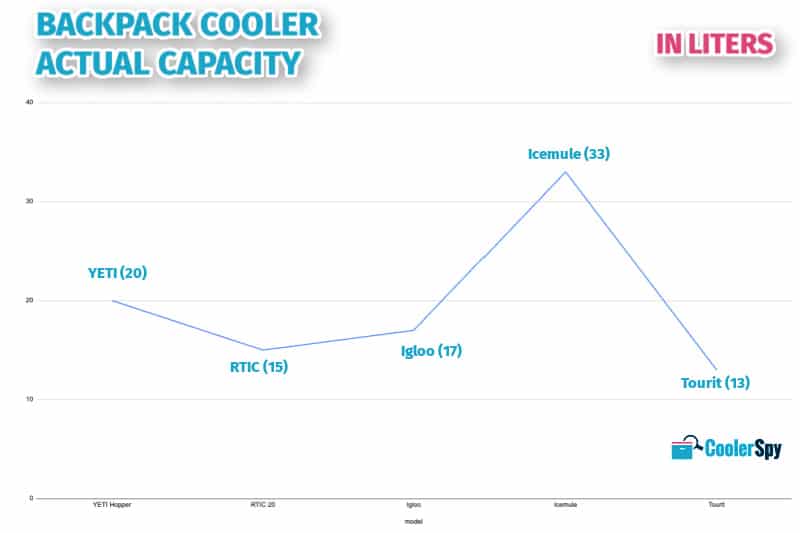
The Icemule has the most liquid capacity, with the YETI coming in second. If you’re looking to haul a picnic for six, I would recommend one of those two backpack coolers as those are the only ones that have that kind of capacity.
Insulation
The Igloo came in fourth (out of five) in my insulation tests. Check out the graph below:
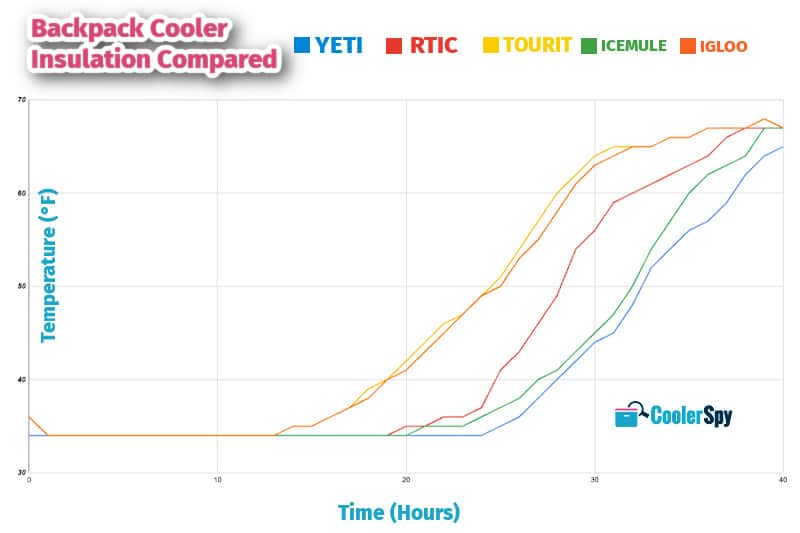
I ran my test for 40 hours, at which point all the coolers had been sitting at room temperature (except the YETI).
The Igloo held its contents below 40 degrees (the food-safe temperature limit) for 19 hours.
How long does the Igloo backpack cooler hold ice for?
My Igloo MaxCold Voyager held ice for 16 hours.

And if it’s frosty beers you’re after, the Igloo kept cans at or below 50 degrees for 25 hours, compared to the YETI’s 33-hour performance.
The YETI Hopper M20 was the king of insulation in my tests, but you can see that the Icemule wasn’t far behind at all, which really surprised me.
The Igloo and the Tourit were definitely the laggards in this area, but they’re also the only options under $100. Still, the Igloo outperformed the Tourit, despite the fact that the Tourit is smaller (smaller capacity usually means better ice retention when using an equal amount of ice).
Durability
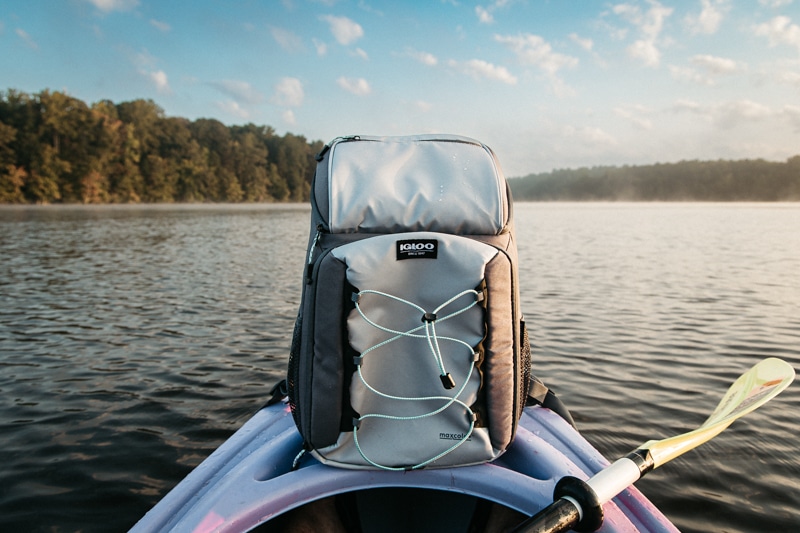
Durability is the biggest factor weighing on why I recommend the Icemule over the Igloo.
It’s not that the Igloo isn’t durable—there’s nothing happening to it yet that suggests it’s not well-made.
But when I look at the triple layer rubberized ripstop fabric of the Icemule, plus the stitching in the seams, it’s clear that it’s much better built than the Igloo Voyager.
I should also say that the Igloo Voyager is much better built than the Tourit Cockatoo, so if you’re firm on sticking below $100 for your backpack cooler, then get the Igloo for sure.
I think the Igloo will last long enough for you to get a good deal for your money. But there’s nothing that blows me away about the materials and construction.
If you’re willing to venture above $100, then the quality is disproportionately better. That means while the Icemule is about double the cost of the Igloo, I think you’re getting much more than double the value in terms of durability, comfort, storage space, and adventure-readiness.
Portability
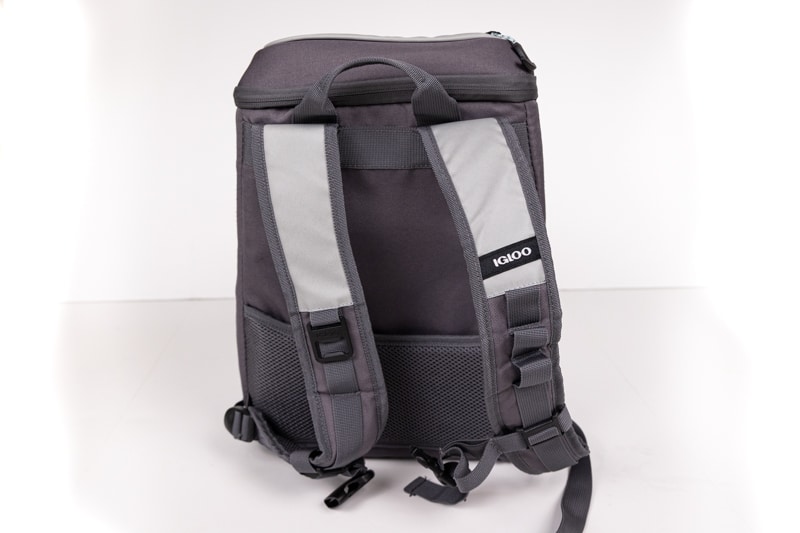
It doesn’t get much more portable than a backpack cooler, and all the options I tested were great—especially when compared to hard coolers.
The Igloo backpack cooler is pretty comfortable when fully loaded—there’s a nice pad for the lower back that can help out if you have some strange oblong objects poking out backwards.

The most comfortable backpack cooler is the YETI Hopper M20, which I felt balanced the weight on your back exceptionally well. The RTIC 20-Can pack and the Tourit Cockatoo didn’t impress me much with their comfort or ease of carrying longer distances.
I’d say the Igloo was somewhere in the middle for comfort.
Features

Igloo loaded the MaxCold Voyager with features: it has two mesh pockets at the sides for storing water bottles or whatever else you want. It also has a front pocket, a main compartment, and a top compartment for easy access to your keys, wallet, and phone.
There’s a nifty metal bottle opener attached to one strap, and there’s some nylon loops on the other strap if you want to attach a carabiner.
Overall, I think Igloo does the best job—even when compared with the expensive YETI Hopper—with thinking of small ways to make the backpack more useful on a camping trip or a hike.
The Igloo MaxCold Voyager offers solid value for money, and if you need a cooler backpack for an upcoming trip, it's not a bad choice. I don't see this lasting more than 5 years though, and I personally would rather get something that I know will last a decade or longer.
What Do Other Reviewers Say?
Some reviewers were dismayed that this backpack doesn’t carry a full 30 cans with ice—just 30 cans without ice. Who wants that?
I think a better expectation is 20 cans with ice, plus places to store your phone, keys, and wallet. In that regard, the Igloo has the most pockets of any cooler I tested, so it has the most versatile storage space. The higher end coolers usually just have one main compartment—the Igloo is much more of an insulated backpack, rather than a cooler you can put on your back.
Igloo MaxCold Voyager Alternatives
YETI Hopper M20
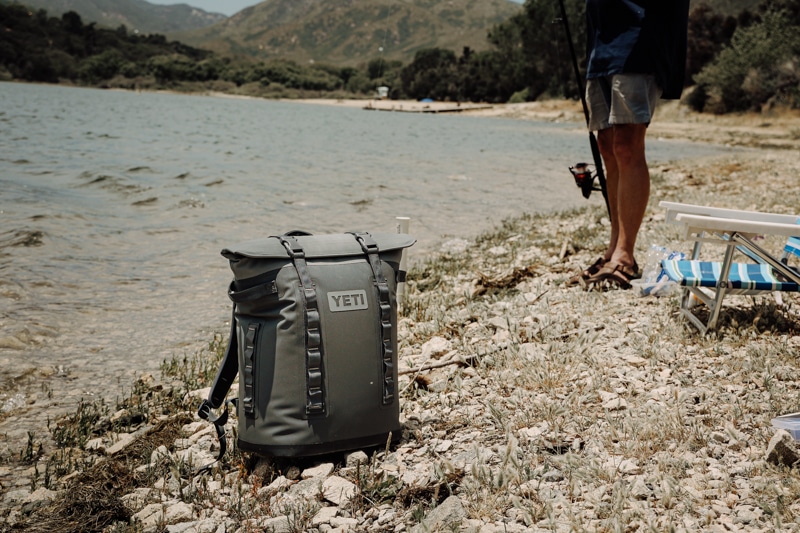
The YETI Hopper M20 is my top pick of all the backpack coolers because it keeps the weight distributed evenly across your back and makes treacherous hiking conditions a little safer.
The Hopper M20 Backpack Soft Cooler allows you to put the day on your back — literally. This hands-free soft cooler keeps you mobile, while an ultra-strong magnet strip keeps the cold locked in and the hot air out.
I tend to get into treacherous hiking conditions often so that’s pretty important to me.
I also like that the YETI has a high density shell that’s stiffer and more abrasion resistant than the rubberized RTIC and Icemule. I think that’ll contribute to the longevity of the cooler. But it does cost over $300, which is a lot for a backpack cooler.
Still, if you’re looking for the best of the best, the YETI Hopper M20 is the best upgrade backpack cooler you can get in my opinion.
Icemule Pro XL 33L Backpack Cooler
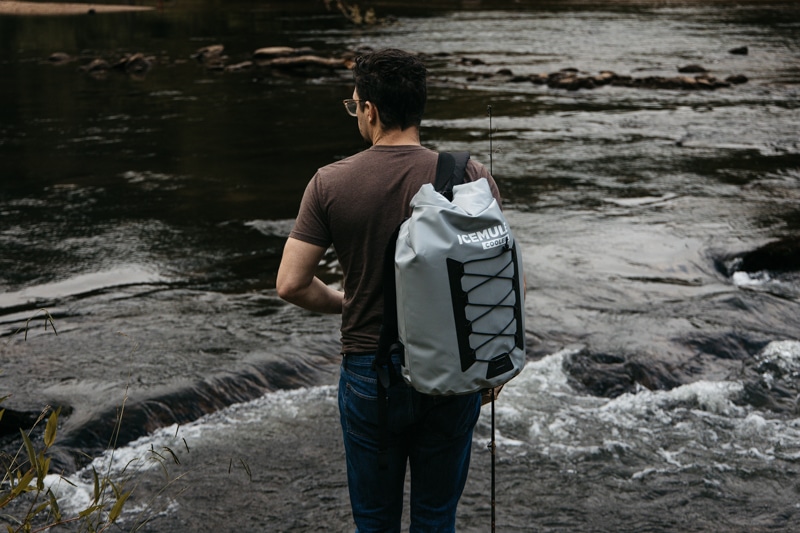
The Icemule Pro is still a big step up in cost from the Igloo, but I think it’s worthy of consideration.
The Icemule Pro XL is my top pick for backpack coolers. I love the way it looks, the insulation is fantastic, and the price is right. It can hold its own against YETI despite being less than half the price.
I can see the Icemule Pro lasting for the rest of your life, and I just don’t see the Igloo backpack cooler doing the same. Igloo uses a standard fabric and the internal waterproof lining is pretty thin.
While the Icemule Pro is about double the cost of the Igloo, I think it goes beyond double the value and longevity. Plus the insulation is fantastic.
My Thoughts Overall On the Igloo Voyager Backpack Cooler
What I Like
- I like the three separate compartments—it acts more like an insulated backpack than a cooler you can carry on your back.
- Of the sub-$100 coolers I tested, Igloo had the best insulation.
- Igloo put a lot of thought into their features: elastic mesh sides, metal bottle opener, t-handles on the zippers, elastic bungee on the front, and nylon webbing on left strap.
What I Don’t Like
- Because the Igloo is built like an insulated backpack rather than a cooler, there are some gaps in the insulation that cause it to underperform compared to other brands (though it still was the best sub-$100 backpack cooler for insulation in my tests).
- Compared to the other backpack coolers I got, I think it’s the worst looking.
Who is the Igloo Voyager for?
The Igloo Voyager is for you if you’re looking to spend less than $100 and you want something that can hold a chill for a few hours—if you only ever need to keep cold temperatures until lunch and you’re not doing anything high-impact, then the Igloo MaxCold Voyager will get the job done.
The Verdict
The Igloo MaxCold Voyager is my top budget-friendly backpack cooler (under $100).
It outperformed the Tourit Cockatoo in just about every way (except I think the Tourit looks cooler, but that’s really not that big of a deal).
While the Igloo is my budget pick, I think it’s really worth considering the Icemule Pro.
The Icemule Pro does cost about double what the Igloo costs, and you’re breaking that $100 level, but the value you get is well worth it in my opinion.
The waterproof lining in the Igloo is pretty thin, and I can see something catching it and tearing it fairly easily—then it’s game over for the cooler.
But the Icemule Pro is a tough beast, it’s waterproof, and it’s made with rubberized ripstop fabric that is really hard to destroy. Plus the insulation is close to YETI level, but at a far lower cost.
The YETI Hopper M20 is the best of the best, but it costs over five times more than the Igloo, so it seems a little ridiculous to recommend it here. Still, if quality is your utmost consideration, then the YETI is the way.
If you get the Igloo MaxCold Voyager, I think you’ll be happy with your purchase. And I also think you’ll be buying another backpack cooler within the next five years. The Icemule might sting a bit more on the upfront costs, but I bet it would be the last backpack cooler you’ll need.
The Igloo MaxCold Voyager offers solid value for money, and if you need a cooler backpack for an upcoming trip, it's not a bad choice. I don't see this lasting more than 5 years though, and I personally would rather get something that I know will last a decade or longer.
FAQs
Can I put ice in my Igloo backpack cooler?
Yes, you can and should put ice in your Igloo backpack cooler. I recommend two to three pounds of ice to keep everything cold while still leaving plenty of room for your snackies.
How long does the Igloo backpack cooler keep cold?
My Igloo backpack cooler kept its contents below room temperature for 31 hours. It held contents below 40 degrees (food-safe temp) for 19 hours, and below 50 degrees (chilled drinks) for 25 hours.
Is the Igloo backpack cooler waterproof?
No, the Igloo MaxCold Voyager isn’t waterproof, nor is it air-tight.
